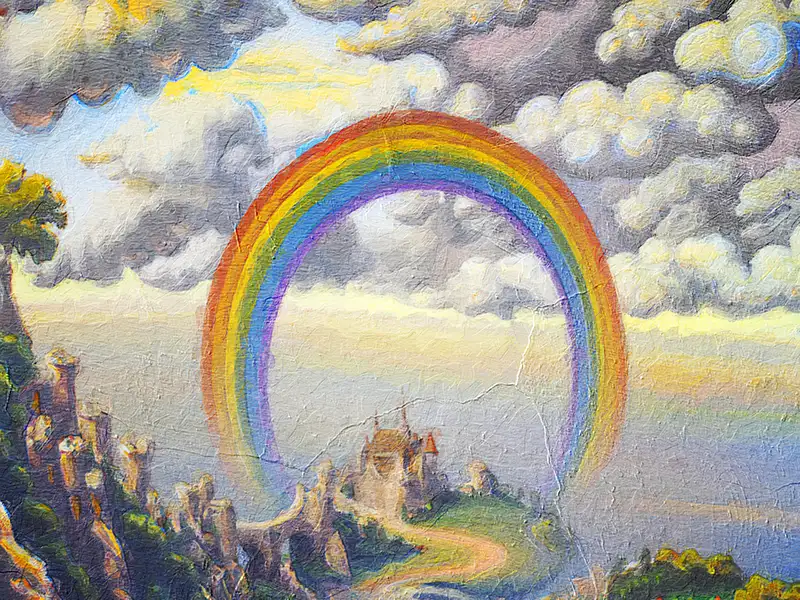Are Rainbows really circles?
Have you ever looked up at the sky and seen a beautiful rainbow after a rainstorm? If so, you might have noticed that rainbows are often depicted as circles in art and literature. But are rainbows really circles, or is this just a myth?
In this article, we’ll take a closer look at the shape of rainbows and explore the science behind these colorful natural wonders. We’ll learn about the geometry of rainbows and see how they are formed, and we’ll also consider the cultural significance of rainbows and how they have been depicted in different cultures throughout history.
So if you’ve ever wondered about the shape of rainbows and whether they are really circles, read on to learn more!
The Science Behind Rainbows
To understand the shape of rainbows, it’s helpful to first understand how they are formed. Rainbows are created when light is refracted, or bent, as it passes through water droplets in the air.
When sunlight passes through a raindrop, it is separated into its different colors. This happens because different colors of light have different wavelengths, and each wavelength is refracted, or bent, by a different amount as it passes through the water droplet.
As the light is refracted, it is also reflected, or bounced, off the back of the raindrop. This causes the different colors of light to spread out and create a circular arc, or a rainbow.
So why do rainbows appear to be circles? It’s because rainbows are actually circular arcs that are formed when light is refracted and reflected by water droplets in the air. The shape of the rainbow depends on the size of the water droplets and the angle at which the light hits them.
Overall, the science behind rainbows is quite complex, but it helps explain why they are often depicted as circles in art and literature.
The Geometry of Rainbows
The geometry of rainbows refers to the way that they are shaped and formed. As we learned earlier, rainbows are created when light is refracted and reflected by water droplets in the air. This causes the different colors of light to spread out and create a circular arc, or a rainbow.
The shape of the rainbow depends on the size of the water droplets and the angle at which the light hits them. If the water droplets are small, the rainbow will be more circular. If the water droplets are larger, the rainbow will be more flattened and elongated.
The angle at which the light hits the water droplets also affects the shape of the rainbow. If the light is hitting the droplets at a steep angle, the rainbow will be more circular. If the light is hitting the droplets at a shallow angle, the rainbow will be more flattened.
Overall, the geometry of rainbows is determined by the way that light is refracted and reflected by water droplets in the air. This helps explain why rainbows are often depicted as circles in art and literature.
Myth or Fact: Are Rainbows Really Circles?
Now that we’ve learned about the science and geometry of rainbows, let’s consider whether rainbows are really circles.
According to the science and geometry of rainbows, they are actually circular arcs that are formed when light is refracted and reflected by water droplets in the air. The shape of the rainbow depends on the size of the water droplets and the angle at which the light hits them.
However, rainbows are often depicted as perfect circles in art and literature, which can lead people to believe that this is how rainbows actually look in nature. In reality, rainbows are not perfect circles, but rather they are circular arcs that can vary in shape depending on the conditions in which they are formed.
So, is the idea that rainbows are circles a myth or a fact? It’s a bit of both. While rainbows are not perfect circles, they are often depicted as such in art and literature, which can lead people to believe that this is how they look in nature.
Overall, the shape of rainbows is a combination of both myth and fact. While they are not perfect circles, they are often depicted as such in art and literature, and they are formed by the refraction and reflection of light by water droplets in the air.
The Cultural Significance of Rainbows
Rainbows have taken on different meanings and significance in different cultures throughout history. In many cultures, rainbows have been seen as a symbol of hope and a reminder of the beauty of the natural world. They are often depicted in art and literature as a way to bring beauty into the world and to inspire people to look for the good in life.
In some cultures, rainbows have been seen as a symbol of divine intervention and a promise from God. In many cultures, rainbows have been seen as a way for the gods to communicate with the mortal world and to offer hope and guidance to those who seek it.
The rainbow flag, which is a symbol of the LGBTQ+ community, is a good example of how rainbows have taken on different meanings in different cultures. The rainbow flag represents the diversity of the LGBTQ+ community and promotes a message of acceptance and inclusivity.
Overall, rainbows have taken on many different meanings and significance in different cultures throughout history. They are often depicted as a symbol of hope, divine intervention, and acceptance, and they continue to inspire people all around the world.
